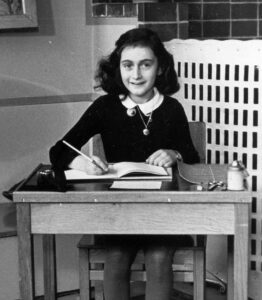#RIP #OTD in 1929 founder of The Coca-Cola Company, 41st mayor of Atlanta, Asa Candler died at Wesley Memorial Hospital in Atlanta aged 77. Westview Cemetery, Atlanta
 On this approximate day in 1945, victim of the Holocaust and diarist, Anne Frank, died in the Bergen-Belsen concentration camp in Lower Saxony, Nazi Germany at the age of 15. Born Annelies Marie Frank on 12 June 1929 in Frankfurt am Main, Germany. The Frank family moved from Germany to Amsterdam in 1933, the year the Nazis gained control over Germany. By the beginning of 1940, they were trapped in Amsterdam by the Nazi occupation of the Netherlands. As persecutions of the Jewish population increased in July 1942, the family went into hiding in the hidden rooms of Anne’s father, Otto Frank’s, office building. After two years, the group was betrayed and transported to concentration camps. Anne and her sister, Margot, were eventually transferred to the Bergen-Belsen concentration camp, where they both died of typhus in March 1945. Otto, the only survivor of the family, returned to Amsterdam after the war to find that Anne’s diary had been saved, and his efforts led to its publication in 1947. It was translated from its original Dutch and first published in English in 1952 as The Diary of a Young Girl. The diary, which was given to Anne on her 13th birthday, chronicles her life from 12 June 1942 until 1 August 1944.
On this approximate day in 1945, victim of the Holocaust and diarist, Anne Frank, died in the Bergen-Belsen concentration camp in Lower Saxony, Nazi Germany at the age of 15. Born Annelies Marie Frank on 12 June 1929 in Frankfurt am Main, Germany. The Frank family moved from Germany to Amsterdam in 1933, the year the Nazis gained control over Germany. By the beginning of 1940, they were trapped in Amsterdam by the Nazi occupation of the Netherlands. As persecutions of the Jewish population increased in July 1942, the family went into hiding in the hidden rooms of Anne’s father, Otto Frank’s, office building. After two years, the group was betrayed and transported to concentration camps. Anne and her sister, Margot, were eventually transferred to the Bergen-Belsen concentration camp, where they both died of typhus in March 1945. Otto, the only survivor of the family, returned to Amsterdam after the war to find that Anne’s diary had been saved, and his efforts led to its publication in 1947. It was translated from its original Dutch and first published in English in 1952 as The Diary of a Young Girl. The diary, which was given to Anne on her 13th birthday, chronicles her life from 12 June 1942 until 1 August 1944.
 The Final Footprint – Anne and her sister Margot were buried in a mass grave at Bergen-Belsen, the exact whereabouts are not known. A memorial to the sisters has been erected there. A bronze statue of Anne was erected outside the Westerkerk in Amsterdam. A bronze plaque in Anne’s memory was placed at Beth Olam Cemetery in Los Angeles. The plaque has the term of endearment; A Star shines in the dark. The plaque also has a picture of Anne cast into the bronze and the following inscription from her diary; “This is a photo as I wish I still was. If so, I would still have a chance to come to Hollywood.”
The Final Footprint – Anne and her sister Margot were buried in a mass grave at Bergen-Belsen, the exact whereabouts are not known. A memorial to the sisters has been erected there. A bronze statue of Anne was erected outside the Westerkerk in Amsterdam. A bronze plaque in Anne’s memory was placed at Beth Olam Cemetery in Los Angeles. The plaque has the term of endearment; A Star shines in the dark. The plaque also has a picture of Anne cast into the bronze and the following inscription from her diary; “This is a photo as I wish I still was. If so, I would still have a chance to come to Hollywood.”
| Charlie Parker | |
|---|---|
On this day in 1955, jazz saxophonist and composer, Yardbird or Bird, Charlie Parker died at the age of 34 in the suite of his friend and patroness Baroness Pannonica de Koenigswarter at the Stanhope Hotel in Manhattan, while watching The Dorsey Brothers’ Stage Show on television. Born Charles Parker Jr. on August 29, 1920 in Kansas City, Missouri.
Parker was a highly influential jazz soloist and a leading figure in the development of bebop, a form of jazz characterized by fast tempos, virtuosic technique and advanced harmonies. Parker was a fast virtuoso, and he introduced revolutionary harmonic ideas including rapid passing chords, new variants of altered chords, and chord substitutions. His tone ranged from clean and penetrating to sweet and somber. Parker acquired the nickname “Yardbird” early in his career. This, and the shortened form “Bird”, continued to be used for the rest of his life, inspiring the titles of a number of Parker compositions, such as “Yardbird Suite”, “Ornithology”, “Bird Gets the Worm”, and “Bird of Paradise”. Parker was an icon for the hipster subculture and later the Beat Generation, personifying the jazz musician as an uncompromising artist and intellectual rather than just an entertainer.
Parker suffered from depression and heroin addiction. After Parker’s 2 year old daughter passed away from pneumonia. He attempted suicide twice in 1954, which landed him in a mental hospital.
When Parker received his discharge from the hospital, he was clean and healthy. Before leaving California, he recorded “Relaxin’ at Camarillo” in reference to his hospital stay. He returned to New York, resumed his addiction to heroin and recorded dozens of sides for the Savoy and Dial labels, which remain some of the high points of his recorded output. Many of these were with his so-called “classic quintet” including Davis and Roach
The Final footprint
The official causes of death were lobar pneumonia and a bleeding ulcer, but Parker also had an advanced case of cirrhosis and had suffered a heart attack. The coroner who performed his autopsy mistakenly estimated Parker’s 34-year-old body to be between 50 and 60 years of age. His wish was to be quietly interred in New York City.
Dizzy Gillespie paid for the funeral arrangements and organized a lying-in-state, a Harlem procession as well as a memorial concert. Parker’s body was flown back to Missouri, in accordance with his mother’s wishes. Berg criticized Parker’s family for giving him a Christian funeral, even though they knew he was a confirmed atheist. Parker was buried at Lincoln Cemetery in Missouri, in a hamlet known as Blue Summit, located close to I-435 and East Truman Road.
Miles Davis once said, “You can tell the history of jazz in four words: Louis Armstrong. Charlie Parker.”
Bird is a 1988 American biographical film, produced and directed by Clint Eastwood of a screenplay written by Joel Oliansky. It is constructed as a montage of scenes from Parker’s life, from his childhood in Kansas City, through his death. Forest Whitaker portrays Parker in the film.
| Beatrice Wood | |
|---|---|
 Beatrice Wood, 1908 |
|

Untitled (Two Women) earthenware with glazes by Beatrice Wood, 1990
On this day in 1998, artist Beatrice Wood died in Ojai, California at the age of 105. Born Beatrice Wood on March 3, 1893 in San Francisco. Wood was involved in the Avant Garde movement in the United States. She founded The Blind Man magazine in New York City with French artist Marcel Duchamp and writer Henri-Pierre Roché in 1917. She had earlier studied art and theater in Paris, and was working in New York as an actress. She later worked at sculpture and pottery. Wood was characterized as the “Mama of Dada.”
She partially inspired the character of Rose DeWitt Bukater in James Cameron‘s 1997 film, Titanic after the director read Wood’s autobiography while developing the film.
Despite her parents’ strong opposition, Wood insisted on pursuing a career in the arts. Eventually her parents agreed to let her study painting. Because she was fluent in French, they sent her to Paris, where she studied acting at the Comédie-Française and art at the prestigious Académie Julian.
The Blind Man magazine was one of the earliest manifestations of the Dada art movement in the United States. The publication was intended to defend the submission of a urinal by R. Mutt to the First Exhibition of the Society of Independent Artists in April 1917. Wood wrote the oft-quoted statement that appeared in the publication as an unsigned editorial: “As for plumbing, that is absurd. The only works of art America has given are her plumbing and her bridges.”
Though she was most involved with Roché, the two often spent time with Duchamp, creating a kind of love triangle. Since the late 20th century, biographies of Wood have associated Roché’s 1956 novel Jules et Jim (and the 1962 film adaptation), with the relationship among Duchamp, Wood, and Roché. Other sources link their triangle to Roché’s unfinished novel, Victor.
Beatrice Wood commented on this topic in her 1985 autobiography, I Shock Myself:
Roché lived in Paris with his wife Denise, and had by now written Jules et Jim … Because the story concerns two young men who are close friends and a woman who loves them both, people have wondered how much was based on Roché, Marcel, and me. I cannot say what memories or episodes inspired Roché, but the characters bear only passing resemblance to those of us in real life!
Jules et Jim is properly associated with the triangle among Roché, German writer Franz Hessel, and Helen Grund, who married Hessel.
At the age of 90, Wood became a writer, having been encouraged to write by her friend, Anais Nin, a French writer. Her best-known book is her autobiography, I Shock Myself (1985). When asked the secret to her longevity, she would respond, “I owe it all to chocolate and young men.” Beatrice Wood kept daily journals for 85 years.
The Final Footprint
Woods was cremated and her cremains were scattered in Ojai.
#RIP #OTD in 2001 author (The Osterman Weekend, The Holcroft Covenant, The Apocalypse Watch, The Bourne Trilogy) Robert Ludlum died of a heart attack at his home in Naples, Florida, aged 73. Cremation
Have you planned yours yet?
Follow TFF on twitter @RIPTFF






